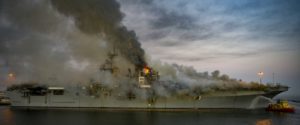The Navy’s top officer blamed many problems with the service on institutional issues of poor self-assessment and correction that tends to bury mistakes and minimize issues.
“Despite the momentum that we are building, we also have to be honest with ourselves. We are not operating to our full potential. Over the last few years I think we’ve learned some hard truths about ourselves. We have seen too many examples of significant organizational drift – instances of unsatisfactory unit performance, late completion of shipyard maintenance availabilities, and failure to deliver gamechanging , innovative technologies and concepts at pace, Chief of Naval Operations Adm. Mike Gilday said Tuesday during a speech broadcast here to the Surface Navy Association’s annual symposium.
Gilday said he sees two factors keeping the Navy from an optimal position: the gap between best and worst performers is too wide and outdated approaches to learning and problem solving.
“The gap between our most and least capable performers is way too large. There is unacceptable variability in our performance. This variability cuts across different units, organizations, and communities, both at sea and ashore. At the lowest end of the performance spectrum, we see tragic results like the Bonhomme Richard fire along with 14 other major fire events in the past 12 years, and excessive cost and schedule overruns in key acquisition programs,” Gilday said.
“The root cause for this performance gap is an outdated approach to institutional learning and problem solving. Essentially, how we share learning and solve problems across the Navy, which has focused too long on instructions, rules, and checklists rather than dynamic learning and innovation,” he continued.
Great to speak at #SNA2022 today about the #NAVPLAN Implementation Framework #NIF & the efforts we are taking as a self-assessing & self-correcting organization to Get Real & Get Better #GRGB. Proud of our entire @USNavy team! #Warfighter #ForceToBeReckonedWith pic.twitter.com/Orm8r3YtFF
— USNavyCNO (@USNavyCNO) January 11, 2022
Gilday said issues like the repeated fire events aboard vessels show the Navy as an institution has not routinely absorbed lessons in an enduring manner.
“When something bad happens we often view poor performance as one-off failure, put short term adjustments in place and apply burdensome regulations, guidance and oversight. We can and need to do better and apply the lessons learned of our hard earned experience.”
Gilday argued the way out of the problem is to become more self-assessing and self-correcting, be more realistic about performance, and identify problems before they become more systemic issues.
“We need to institutionalize the leadership behaviors and the problem solving skills that our strongest units demonstrate and then scale it across the Navy to enrich the power of our people. To get there it starts with step one – we need to get real,” he said.
Navy leaders must be “ruthlessly honest” about how they self-assess and understand their unit’s performance and capabilities.
“They have to act boldly and accept professional risk. They need to elevate problems, welcome transparency, clearly articulate challenges and leave their egos at the door. If our performance is not as good as we thought, we do not hide our assessment or ‘keep it inside the lifelines.’ We embrace the red as the opportunity to get better. And then we share our understanding with the teams on and off the bench so that they can help make us better,” Gilday said.
The CNO said the Navy’s best organizations can tell when they have passed the test “because they can accurately predict their performance 30 days, three months, six months into the future. They have a strong understanding of their capabilities and their constraints.”

Gilday underscored the highest performing units consistently have a trait in the ability to accurately self-assess.
“It is well understood that if we do not identify our mistakes and recognize opportunity to do better, we merely plateau, and we don’t move beyond mere status quo performance. The critical imperative here is that the self-assessment culture and tools must be widely adapted across our Navy. I expect every sailor to adopt this plan today. Anything less would shortchange our team and our teammates.”
Gilday also said he will work on improving this kind of learning by revamping the Naval Safety Center into a new Navy Safety Command.
“I owe it to you to redesign and improve our organizational structures so the fleet can refocus on learning and supporting the sailors.”
The new Navy Safety Command will be headed by a two-star admiral with experience as a carrier strike group commander “who will report directly to me,” Gilday said.
That command will evaluate how the entire Navy, from the fleet commander down, manage safety and risk, and it will grade how effectively commands are self-assessing performance.”
The CNO said the Navy’s Board of Inspection and Survey (INSURV) is a model for how the new command will perform.
Shifting the safety center to a safety command is the first recommendation from the Major Fires Review report produced after the investigation of the Bonhomme Richard fire.
The report said the Naval Safety Center missions, functions and tasks should be modified to create a more effective organization “responsible for establishing policy, conducting investigations, assessing trends, recommending resourcing, and overseeing Fleet implementation and enforcement of non-nuclear safety standards and performance.”
“A newly enabled and refocused Naval Safety Command (vice Center) would provide a layer of defense-in-depth for non-nuclear safety oversight and enforcement but would not diminish the authority, responsibility, and accountability of the chain of command. The intent is to ensure there is a single individual at the echelon 1 level who has ownership and is overall responsible for damage control and fire safety, and who will closely coordinate with other key stakeholders,” the report added.
The Major Fires Review said this recommendation was related to the major finding of ineffective learning as a primary issue that contributed to the lack of enduring change and recurrence of major shipboard fires over the review.